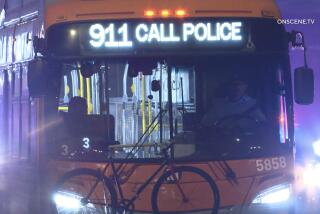Graffiti mars school media event
The two-block walk from the MTA bus stop to campus has often been a frightening ordeal for students at the Santee Education Complex just south of downtown Los Angeles.
Some have complained of gang activity and being harassed or robbed -- including one student who was held up at gunpoint. The area was branded by Los Angeles Unified School District Supt. David L. Brewer as “one of the worst blocks” in the area.
On Monday, Brewer, Los Angeles Mayor Antonio Villaraigosa and other officials trumpeted a new tactic to ease the fears: locating a bus stop directly behind the school so students don’t have to navigate through a gang-plagued neighborhood.
But just as officials were applauding their accomplishment, they got a fresh perspective on campus security problems when their bus got tagged.
While the crowded Metro bus carrying Brewer, Villaraigosa and a crowd of journalists was stopped at Washington Boulevard and Maple Avenue, an unidentified youth believed to be a Santee student dashed up and scrawled graffiti on a side window.
As word of the incident rippled through the crowd, Villaraigosa asked that the bus be stopped to catch the tagger. Officials soon thought better of the idea, and rather than create a traffic hazard at a busy intersection, pledged to identify and deal with the student today.
Still, the mayor was heard to say that the boy should do “a lot of community service” after being caught.
Officials didn’t seem to see any irony or humor in the timing of the brazen vandalism. “It’s a cry out for help,” said Vince Carbino, Santee’s principal. He said he will meet with the youth, together with one of the school’s social workers, to “help the student and get him on the right track.”
Carbino said that once the student’s identity is confirmed, his name will be passed on to the Los Angeles Police Department. Carbino, who is also a licensed child counselor and a former police officer, said the student did not appear to be a gang member and most likely scribbled on the window for “attention-seeking purposes.”
Carbino said the tagging was an example of what his students see on a daily basis. “They see kids writing on walls, kids writing on business walls, gang graffiti and tagging,” he said.
All the same, Monday was an upbeat day for a group of about 30 students called the Peace Committee who had been pushing for months for a bus stop closer to campus. Eventually, they spoke with Brewer, who in turn called Villaraigosa. The Metropolitan Transportation Authority was brought in and plans were made to add a bus stop behind the school and out of the range of gang-related crime.
On Monday afternoon, Jose Rios, a student member of the Peace Committee, thanked Brewer, Villaraigosa and other school board and MTA officials for working together to add the new stop last week at 23rd Street and Maple Avenue.
“Now we don’t have to worry about going home in terror about being jacked or robbed,” said Rios, a 17-year-old senior, who was held up at gunpoint for his iPod last year.
The area is so plagued with gang activity that many of the school’s approximately 3,300 students have skipped after-school activities to avoid walking to the old stop at Adams Boulevard and Maple Avenue. The two blocks along Maple Avenue, filled with small markets, a coin laundry and a hardware store, account for 30 to 40 gang-related incidents a month, Carbino said.
About 600 students used the route before the addition of the new bus stop, he said. Now that the fear of being harassed or attacked by a gang member has significantly decreased, Carbino said, 1,200 to 1,400 students will use the bus after they leave class, tutoring, drama or athletics practices.
“They will no longer have to go through gang territory,” he said. “They will have less anxiety and be able to focus on their academics rather than their well-being.”
More to Read
Sign up for Essential California
The most important California stories and recommendations in your inbox every morning.
You may occasionally receive promotional content from the Los Angeles Times.










